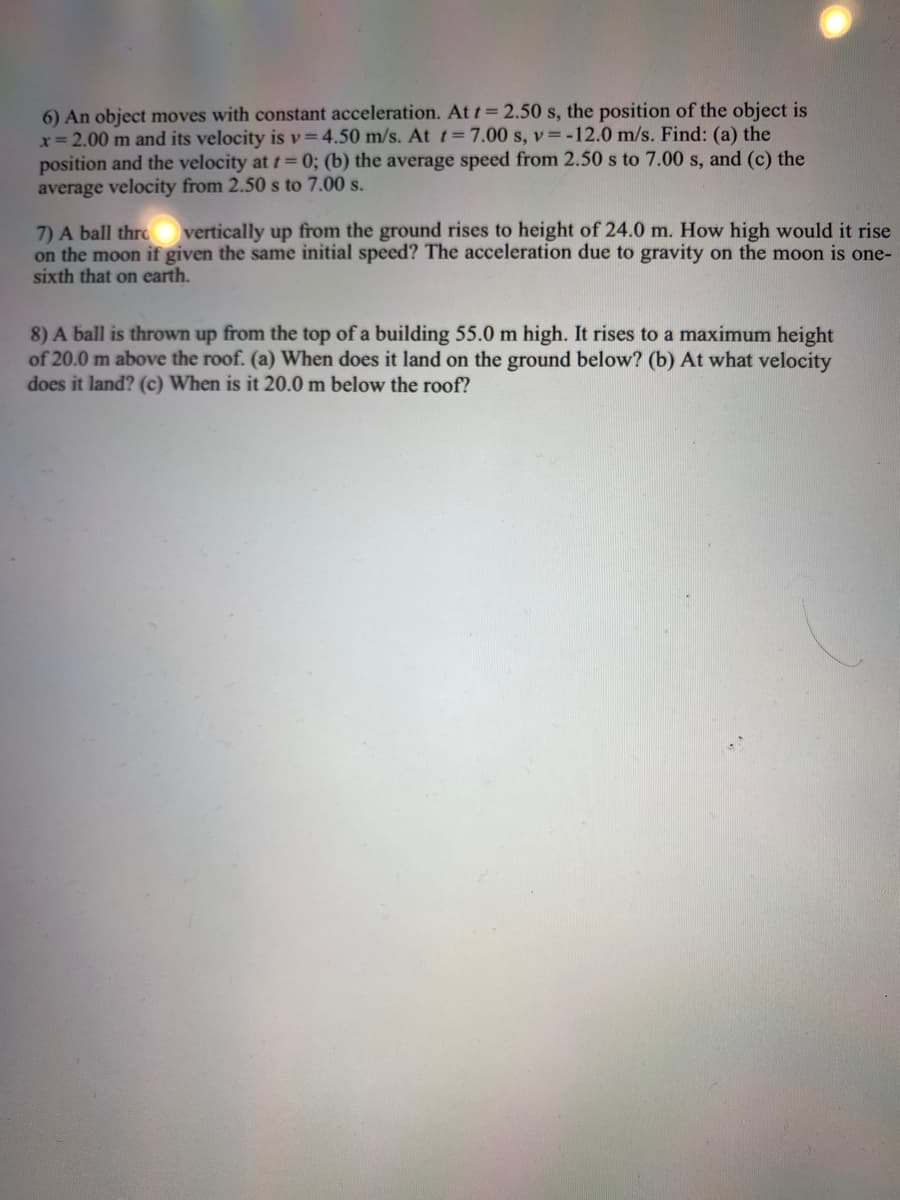6) An object moves with constant acceleration. At t= 2.50 s, the position of the object is x= 2.00 m and its velocity is v=4.50 m/s. At t=7.00 s, v=-12.0 m/s. Find: (a) the position and the velocity at t 0; (b) the average speed from 2.50 s to 7.00 s, and (c) the average velocity from 2.50 s to 7.00 s.
6) An object moves with constant acceleration. At t= 2.50 s, the position of the object is x= 2.00 m and its velocity is v=4.50 m/s. At t=7.00 s, v=-12.0 m/s. Find: (a) the position and the velocity at t 0; (b) the average speed from 2.50 s to 7.00 s, and (c) the average velocity from 2.50 s to 7.00 s.
Principles of Physics: A Calculus-Based Text
5th Edition
ISBN:9781133104261
Author:Raymond A. Serway, John W. Jewett
Publisher:Raymond A. Serway, John W. Jewett
Chapter2: Motion In One Dimension
Section: Chapter Questions
Problem 23P: The driver of a car slams on the brakes when he sees a tree blocking the road. The car slows...
Related questions
Question
For number 6 part a b and c can you show all work formula to find velocity ?

Transcribed Image Text:6) An object moves with constant acceleration. At t = 2.50 s, the position of the object is
x= 2.00 m and its velocity is v=4.50 m/s. At t=7.00 s, v= -12.0 m/s. Find: (a) the
position and the velocity at t= 0; (b) the average speed from 2.50 s to 7.00 s, and (c) the
average velocity from 2.50 s to 7.00 s.
vertically up from the ground rises to height of 24.0 m. How high would it rise
7) A ball thre
on the moon if given the same initial speed? The acceleration due to gravity on the moon is one-
sixth that on carth.
8) A ball is thrown up from the top of a building 55.0 m high. It rises to a maximum height
of 20.0 m above the roof. (a) When does it land on the ground below? (b) At what velocity
does it land? (c) When is it 20.0 m below the roof?
Expert Solution
This question has been solved!
Explore an expertly crafted, step-by-step solution for a thorough understanding of key concepts.
This is a popular solution!
Trending now
This is a popular solution!
Step by step
Solved in 4 steps with 4 images

Knowledge Booster
Learn more about
Need a deep-dive on the concept behind this application? Look no further. Learn more about this topic, physics and related others by exploring similar questions and additional content below.Recommended textbooks for you

Principles of Physics: A Calculus-Based Text
Physics
ISBN:
9781133104261
Author:
Raymond A. Serway, John W. Jewett
Publisher:
Cengage Learning

University Physics Volume 1
Physics
ISBN:
9781938168277
Author:
William Moebs, Samuel J. Ling, Jeff Sanny
Publisher:
OpenStax - Rice University

Principles of Physics: A Calculus-Based Text
Physics
ISBN:
9781133104261
Author:
Raymond A. Serway, John W. Jewett
Publisher:
Cengage Learning

University Physics Volume 1
Physics
ISBN:
9781938168277
Author:
William Moebs, Samuel J. Ling, Jeff Sanny
Publisher:
OpenStax - Rice University